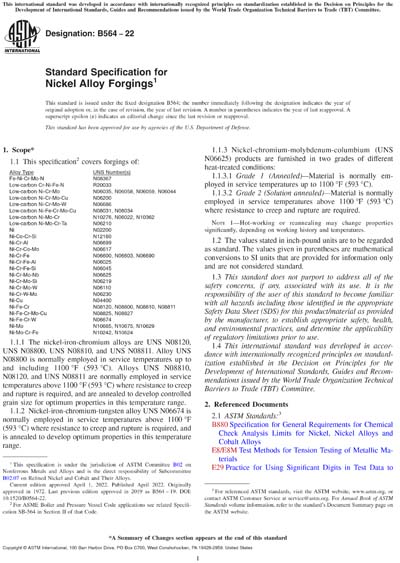Most recent
ASTM B564-22
Standard Specification for Nickel Alloy Forgings
1.1This specification2 covers forgings of:
1.1.1The nickel-iron-chromium alloys are UNS N08120, UNS N08800, UNS N08810, and UNS N08811. Alloy UNS N08800 is normally employed in service temperatures up to and including 1100 °F (593 °C). Alloys UNS N08810, N08120, and UNS N08811 are normally employed in service temperatures above 1100 °F (593 °C) where resistance to creep and rupture is required, and are annealed to develop controlled grain size for optimum properties in this temperature range.
1.1.2Nickel-iron-chromium-tungsten alloy UNS N06674 is normally employed in service temperatures above 1100 °F (593 °C) where resistance to creep and rupture is required, and is annealed to develop optimum properties in this temperature range.
1.1.3Nickel-chromium-molybdenum-columbium (UNS N06625) products are furnished in two grades of different heat-treated conditions:
1.1.3.1Grade 1 (Annealed) - Material is normally employed in service temperatures up to 1100 °F (593 °C).
1.1.3.2Grade 2 (Solution annealed) - Material is normally employed in service temperatures above 1100 °F (593 °C) where resistance to creep and rupture are required.
Note 1:Hot-working or reannealing may change properties significantly, depending on working history and temperatures.
1.2The values stated in inch-pound units are to be regarded as standard. The values given in parentheses are mathematical conversions to SI units that are provided for information only and are not considered standard.
1.3This standard does not purport to address all of the safety concerns, if any, associated with its use. It is the responsibility of the user of this standard to become familiar with all hazards including those identified in the appropriate Safety Data Sheet (SDS) for this product/material as provided by the manufacturer, to establish appropriate safety, health, and environmental practices, and determine the applicability of regulatory limitations prior to use.
1.4This international standard was developed in accordance with internationally recognized principles on standardization established in the Decision on Principles for the Development of International Standards, Guides and Recommendations issued by the World Trade Organization Technical Barriers to Trade (TBT) Committee.
ASTM International [astm]

